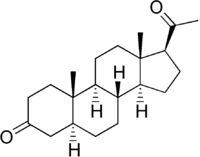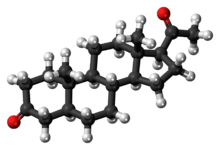5α-Dihydroprogesterone
5α-Dihydroprogesterone (5α-DHP, allopregnanedione,[1] or 5α-pregnane-3,20-dione) is an endogenous progestogen and neurosteroid that is synthesized from progesterone.[2][3] It is also an intermediate in the synthesis of allopregnanolone and isopregnanolone from progesterone.
 | |
 | |
| Names | |
|---|---|
| IUPAC name
(5S,8R,9S,10S,13S,14S,17S)-17-acetyl-10,13-dimethyl-1,2,4,5,6,7,8,9,11,12,14,15,16,17-tetradecahydrocyclopenta[a]phenanthren-3-one | |
| Other names
Allopregnanedione; 5α-Pregnan-3,20-dione | |
| Identifiers | |
3D model (JSmol) |
|
| ChEBI | |
| ChemSpider | |
| ECHA InfoCard | 100.008.453 |
PubChem CID |
|
| UNII | |
| |
| |
| Properties | |
| C21H32O2 | |
| Molar mass | 316.485 g·mol−1 |
Except where otherwise noted, data are given for materials in their standard state (at 25 °C [77 °F], 100 kPa). | |
| Infobox references | |
5α-DHP is metabolized by the aldo-keto reductases (AKRs) AKR1C1, AKR1C2, and AKR1C4 with high catalytic efficiency.[4] AKR1C1 preferentially forms 20α-hydroxy-5α-pregnane-3-one while AKR1C2 preferentially forms allopregnanolone.[4] Similarly AKR1C1 reduces and consequently inactivates allopregnanolone into 5α-pregnane-3α,20α-diol.[4] In contrast to the other AKRs, AKR1C3 has low catalytic efficiency for reduction of 5α-DHP.[4] These AKRs are highly expressed in the human liver and mammary gland but have relatively modest expression in the human brain and uterus.[5]
5α-DHP is an agonist of the progesterone receptor and a positive allosteric modulator of the GABAA receptor (albeit with an affinity for this receptor that is regarded as relatively low (in comparison to 3α-hydroxylated progesterone metabolites such as allopregnanolone and pregnanolone)).[2][3][6][7] It has also been found to act as a negative allosteric modulator of the GABAA-rho receptor.[8] The steroid has been found to possess 82% of the affinity of progesterone for the progesterone receptor in rhesus monkey uterus.[9] 5α-Dihydroprogesterone has been said to possess about 33% of the relative progestogenic potency of progesterone.[10] In addition, it is a weak agonist of the pregnane X receptor (PXR) (EC50 >10,000 μM), with approximately six-fold lower potency relative to its 5β-isomer, 5β-dihydroprogesterone.[11]
Allopregnanolone is transformed back into 5α-DHP by 3α-hydroxysteroid oxidoreductase, and conversion of allopregnanonlone into 5α-DHP is responsible for the progestogenic activity of allopregnanonlone.[6][12][13] 5α-DHP, via the progesterone receptor, and allopregnanolone, via the GABAA receptor, act together to induce lordosis in animals.[12][13] A study found that 41% of allopregnanolone that was administered via injection was transformed into 5α-DHP in the rat brain.[12]
Levels of 5α-DHP have been quantified.[14]
Chemistry
References
- Finn, Deborah A.; Purdy, Robert H. (2007). "Neuroactive Steroids in Anxiety and Stress". Handbook of Contemporary Neuropharmacology. doi:10.1002/9780470101001.hcn026.
- Mellon SH (October 2007). "Neurosteroid regulation of central nervous system development". Pharmacol. Ther. 116 (1): 107–24. doi:10.1016/j.pharmthera.2007.04.011. PMC 2386997. PMID 17651807.
- Guidotti A, Dong E, Matsumoto K, Pinna G, Rasmusson AM, Costa E (November 2001). "The socially-isolated mouse: a model to study the putative role of allopregnanolone and 5alpha-dihydroprogesterone in psychiatric disorders". Brain Res. Brain Res. Rev. 37 (1–3): 110–5. doi:10.1016/s0165-0173(01)00129-1. PMID 11744079.
- Rižner TL, Penning TM (January 2014). "Role of aldo-keto reductase family 1 (AKR1) enzymes in human steroid metabolism". Steroids. 79: 49–63. doi:10.1016/j.steroids.2013.10.012. PMC 3870468. PMID 24189185.
- Penning TM, Burczynski ME, Jez JM, Hung CF, Lin HK, Ma H, Moore M, Palackal N, Ratnam K (October 2000). "Human 3alpha-hydroxysteroid dehydrogenase isoforms (AKR1C1-AKR1C4) of the aldo-keto reductase superfamily: functional plasticity and tissue distribution reveals roles in the inactivation and formation of male and female sex hormones". Biochem. J. 351 (Pt 1): 67–77. doi:10.1042/bj3510067. PMC 1221336. PMID 10998348.
- Rupprecht R, Reul JM, Trapp T, et al. (September 1993). "Progesterone receptor-mediated effects of neuroactive steroids". Neuron. 11 (3): 523–30. doi:10.1016/0896-6273(93)90156-l. PMID 8398145.
- Ocvirk, Rok; Pearson Murphy, Beverley E.; Franklin, Keith B.J.; Abbott, Frances V. (2008). "Antinociceptive profile of ring A-reduced progesterone metabolites in the formalin test". Pain. 138 (2): 402–409. doi:10.1016/j.pain.2008.01.019. ISSN 0304-3959. PMID 18343034.
- Johnston GA (2002). "Medicinal chemistry and molecular pharmacology of GABA(C) receptors" (PDF). Curr Top Med Chem. 2 (8): 903–13. doi:10.2174/1568026023393453. PMID 12171579.
- Illingworth DV, Elsner C, De Groot K, Flickinger GL, Mikhail G (February 1977). "A specific progesterone receptor of myometrial cytosol from the rhesus monkey". J. Steroid Biochem. 8 (2): 157–60. doi:10.1016/0022-4731(77)90040-1. PMID 405534.
- Rogerio A. Lobo; Jennifer Kelsey; Robert Marcus (22 May 2000). Menopause: Biology and Pathobiology. Academic Press. pp. 433–. ISBN 978-0-08-053620-0.
- Lehmann JM, McKee DD, Watson MA, Willson TM, Moore JT, Kliewer SA (1998). "The human orphan nuclear receptor PXR is activated by compounds that regulate CYP3A4 gene expression and cause drug interactions". J. Clin. Invest. 102 (5): 1016–23. doi:10.1172/JCI3703. PMC 508967. PMID 9727070.
- Beyer C, González-Flores O, Ramírez-Orduña JM, González-Mariscal G (February 1999). "Indomethacin inhibits lordosis induced by ring A-reduced progestins: possible role of 3alpha-oxoreduction in progestin-facilitated lordosis". Horm Behav. 35 (1): 1–8. doi:10.1006/hbeh.1998.1457. PMID 10049597.
- Beyer C, Gonzalez-Flores O, Gonzalez-Mariscal G (November 1995). "Ring A reduced progestins potently stimulate estrous behavior in rats: paradoxical effect through the progesterone receptor". Physiol. Behav. 58 (5): 985–93. doi:10.1016/0031-9384(95)00141-5. PMID 8577898.
- Trabert B, Falk RT, Stanczyk FZ, McGlynn KA, Brinton LA, Xu X (September 2015). "Reproducibility of an assay to measure serum progesterone metabolites that may be related to breast cancer risk using liquid chromatography-tandem mass spectrometry". Horm Mol Biol Clin Investig. 23 (3): 79–84. doi:10.1515/hmbci-2015-0026. PMC 4966666. PMID 26353176.